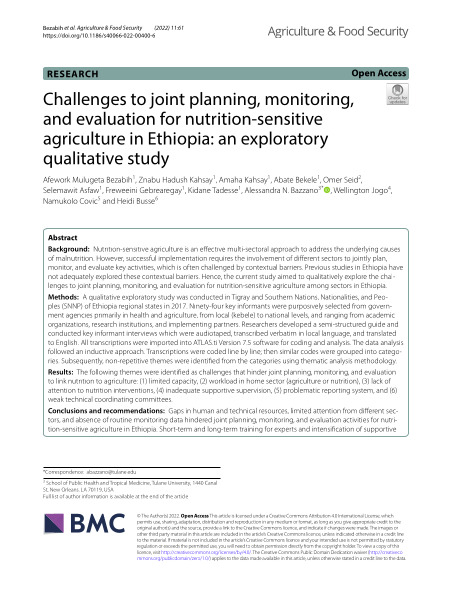Challenges to joint planning, monitoring, and evaluation for nutrition-sensitive agriculture in Ethiopia: an exploratory qualitative study
Abstract
Background
Nutrition-sensitive agriculture is an effective multi-sectoral approach to address the underlying causes of malnutrition. However, successful implementation requires the involvement of different sectors to jointly plan, monitor, and evaluate key activities, which is often challenged by contextual barriers. Previous studies in Ethiopia have not adequately explored these contextual barriers. Hence, the current study aimed to qualitatively explore the challenges to joint planning, monitoring, and evaluation for nutrition-sensitive agriculture among sectors in Ethiopia.
Methods
A qualitative exploratory study was conducted in Tigray and Southern Nations, Nationalities, and Peoples (SNNP) of Ethiopia regional states in 2017. Ninety-four key informants were purposively selected from government agencies primarily in health and agriculture, from local (kebele) to national levels, and ranging from academic organizations, research institutions, and implementing partners. Researchers developed a semi-structured guide and conducted key informant interviews which were audiotaped, transcribed verbatim in local language, and translated to English. All transcriptions were imported into ATLAS.ti Version 7.5 software for coding and analysis. The data analysis followed an inductive approach. Transcriptions were coded line by line; then similar codes were grouped into categories. Subsequently, non-repetitive themes were identified from the categories using thematic analysis methodology.
Results
The following themes were identified as challenges that hinder joint planning, monitoring, and evaluation to link nutrition to agriculture: (1) limited capacity, (2) workload in home sector (agriculture or nutrition), (3) lack of attention to nutrition interventions, (4) inadequate supportive supervision, (5) problematic reporting system, and (6) weak technical coordinating committees.
Conclusions and recommendations
Gaps in human and technical resources, limited attention from different sectors, and absence of routine monitoring data hindered joint planning, monitoring, and evaluation activities for nutrition-sensitive agriculture in Ethiopia. Short-term and long-term training for experts and intensification of supportive supervision may address gaps in capacity. Future studies should address whether routine monitoring and surveillance in nutrition-sensitive multi-sectoral activities provides long-term improvement in outcomes.

